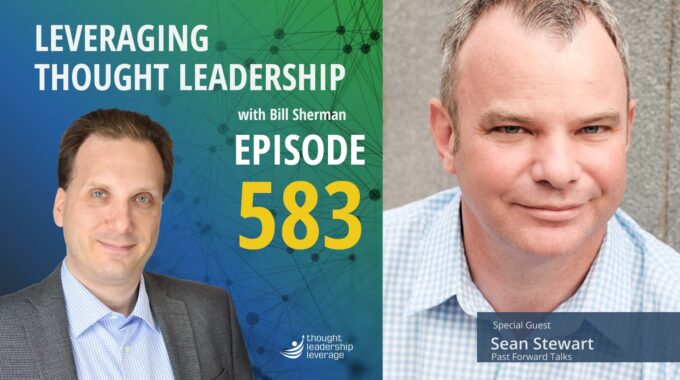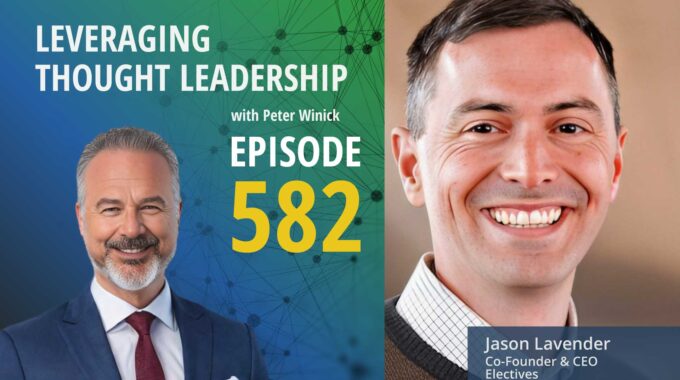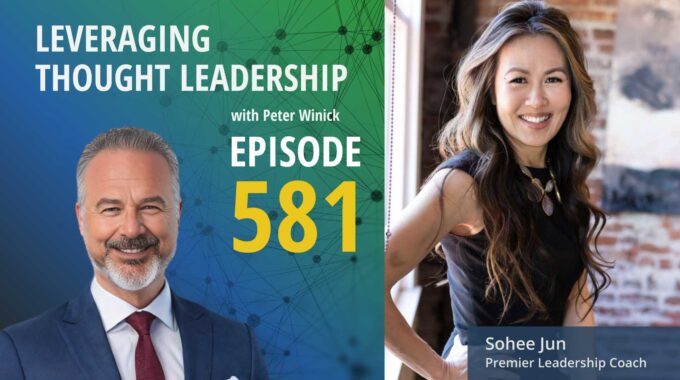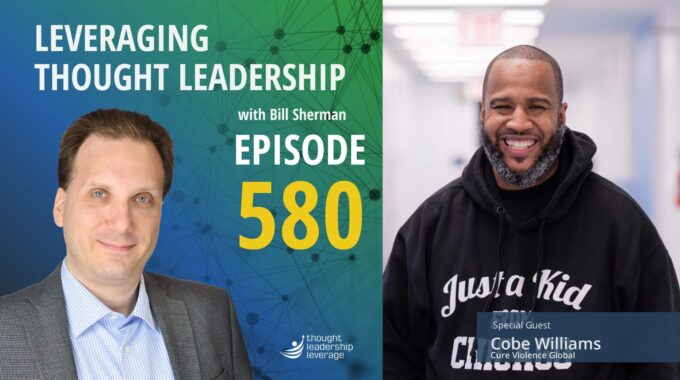Turning Everyday Objects into Tools for Effective Leadership A conversation with Sean Stewart on how…
Blending Disciplines to Create Powerful Thought Leadership | Selena Rezvani
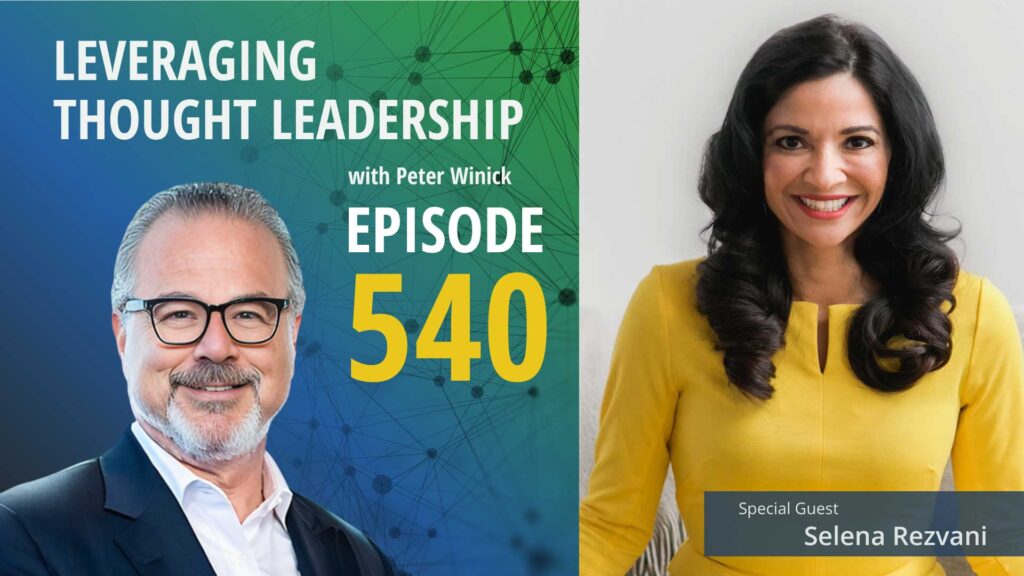
Learning to value yourself and own your authority.
An interview with Selena Rezvani about incorporating her knowledge as a social worker to create impactful thought leadership.
Thought leaders come from a wide variety of backgrounds and skills.
Each unique path leads to inspiration, solutions, and frameworks that can reach niche groups on a personal level.
Selena Rezvani is an internationally recognized author, speaker, and consultant on leadership. Her newest book, a Wall Street Journal bestseller Quick Confidence: Be Authentic, Boost Connections, and Make Bold Bets on Yourself is a guide for overcoming the nine most common obstacles that stand in the way of building authentic confidence.
Selena shares how her journey in thought leadership started while she was a young management consultant whose boss created a policy that all consultants would have to write and present at conferences twice a year. While incredulous at first she was also thrilled at the challenge and agency the opportunity presented.
That push into thought leadership resulted in seeking an MBA to better speak to her audience. Selena shares how during her MBA program she interviewed high performing C-suite level women to discover the commonalities and hardships they face. The result of these interviews came together as her first book The Next Generation of Women Leaders: What You Need to Lead but Won’t Learn in Business School and led to continued relationships with many of the women interviewed and Selena breaking out on her own to further her thought leadership work.
Selena shares how her business continued to grow adding speaking, learning to value herself and the years of previous research that were required to create engaging and actionable speaking engagements.
Selena shares wonderful advice for speakers, authors, leaders, and budding thought leaders on how to create content, build relationships, and measure your own success and self worth.
Three Key Takeaways:
- Great things happen when you bring the frameworks and thinking of one discipline into another that might not typically be blended.
- You have to value yourself. You have to own your authority. Ask for what you need. Don’t settle.
- The success or failure of an experiment is not a measurement of your success or worth. You will either win or you’ll learn.
If you need a strategy to bring your thought leadership to market, Thought Leadership Leverage can assist you! Contact us for more information. In addition, we can help you implement marketing, research, and sales. Let us help you so you can devote yourself to what you do best.

Transcript
Peter Winick And welcome, welcome, welcome. This is Peter Winick. I’m the founder and CEO of Thought Leadership Leverage and you’re joining us on the podcast today, which is leveraging thought leadership today. My guest is Selena Rezvani, who has a pretty extensive bio here. So she is a speaker, a mom and a confidence creator. She is a an author. She’s written a couple of books. The latest one being Quick Confidence. And then she did another one called Push Back and another one called Next Generation of Women Leaders. She’s got a ton of followers on social. She writes for NBC’s Know Your Value. What else do we have here? Lots of other interesting things. Let’s just dive right in. How are you today?
Selena Rezvani I’m good. And thank you for all you do for thought leaders in emerging ones.
Peter Winick Thank you. So on that note, how did you how did you land here? Right. Like there is no linear go here and get an MBA in thought leadership that I know yet maybe there’s an opportunity there. So how did how did this happen for you?
Selena Rezvani Well, like a lot of things, not in a linear way. I was actually a young management consultant and I had a boss who left kind of quickly and inherited a brand new boss. And one of the first changes she made was all the consultants here are going to publish two times a year. They’re going to write articles, original pieces and present at conferences two times a year, and you need to propose it, do it completely on your own, but it’s part of your job. Now.
Peter Winick Let me ask you about that, though, because I love that. But I might be a touch biased, but was that tied to bonus content? Like what was the carrot and what was the stick?
Selena Rezvani It wasn’t. It was she came from an academic background. She had a Ph.D., you know, and I think she said, this is what’s going to build our credibility as a newer practice. And I’m so grateful to her for it, because while I was kind of incredulous, you know, like you’re asking me what you expected done. Goodness. I was also deep down a little bit thrilled by the challenge. And, you know, lo and behold, you know, you write that first article and you get feedback and you tweak it and it ends up out there in the world. And she really started something. And I’m not sure without her push, I would have started when I did, but I’m so grateful because it got me comfortable, it got my feet wet.
Peter Winick So I loved that. So what was the. Reinforcement, Right? Because you could do all that hard work, put it out there, polish it up, etc.. And then crickets. Was there a reinforcement in terms of career trajectory, new client acquisitions, people taking meetings with you that might not have before? Like what was the. Was there a short term maybe mid-term benefit that you were able to notice?
Selena Rezvani I did, but it was more personal and maybe less of a direct benefit, which was agency having a voice, you know, not just being part of a corporation and a team, but suddenly having a unique perspective that you could put out there for people to react to and disagree and agree and build on. And I believe that taste that thought leadership gave me ultimately led me to go off on my own to get up the gumption to do bigger things, like write books and pitch publishers and things like that.
Peter Winick Yeah. So after consulting, you’re building this thought leadership, which is, you know, as as long as you’re aligned to the objectives of your employer during the time that you’re doing it, it’s great. But as we all know, it’s transportable. You get to take your name with you and all the things that you’ve written with you with a couple of Asterix around that. But right. So you now have you’re now known. What do you do next?
Selena Rezvani So I had a kind of untraditional degree for being a management consultant, working on people issues. I had a degree in social work. And while that was great for problem solving and looking at people issues, I couldn’t really speak the language of my clients who were looking at spreadsheets and balance sheets and things like this. And so I got an MBA, and.
Peter Winick Most consulting firms are charging exponentially more than what a typical social worker would be.
Selena Rezvani Charging. Yes, there’s a little difference. They’re actually able to pay my student loans back better, I’ll put it that way. But I pursued an MBA in the evening and I thought, you know what? I love this intersection. It’d be even cooler if I could bring some of what I’m learning and specifically look at women in leadership.
Peter Winick And was you there? So you’ve got because I’m always fascinated by sort of this cross-pollination or where the seams are. So you have women leadership consulting and social work. Right. So the social work is the one that we don’t usually hear in that same bucket. You know, what’s interesting is any time you can bring some of the frameworks, the principles, the thinking of one discipline, social work into management, consulting with a focus, like you said, on leadership and women, all stuff happen.
Selena Rezvani It is. And of course, it doesn’t seem that way at the beginning of the story. Sure. You know, you open some wrong doors along the way, but it does create a hybrid. Very cool. POV and perspective I think is great, but I got the thought leadership opportunity of my life while getting that MBA, and that is I got the chance to direct a piece of research on my own that I could propose needed to be accepted. And I had one female professor at Johns Hopkins, she said. I said, I know just what I want to do. I want to interview C-level women leaders at the top of their game. And she said, You can do it on one on one condition. Selina, You have to go for the Giants. The ones that you think will never entertain an interview. And sure enough, I did, thanks to her and so many of these women said yes. And those interviews changed my life to the point that I pitched it to a publisher. I said, I’m not that unique. This could help other kind of ambitious professionals. And that was such a gift on a silver platter.
Peter Winick Let’s stay there for a minute, because there’s this. I’m loving this conversation because. One of the benefits of thought leadership is the relationship development. Right. So you had no reason to speak to any of these sea level rock star women? Yeah, as a management consultant. Right. Like, they probably wouldn’t be in meetings with them. Right. But now, because you’re doing a piece of research on something that is the interest to you and obviously a of an interest of concern, a passion to them. Now they’re taking those calls and it’s the beginning of a relationship. They want to see how the article comes out. They want. Well, so you talking to. Right. So I think that concept of conflating relationship development slash business development with thought leadership, content development is one that not enough people, in my opinion, really look at strategically and say, oh, this is an interesting way to kill two birds with one stone.
Selena Rezvani Yeah, you’re so right. Especially because you’re kind of enlisting them in a cause more than even a piece of research. You know, they had a clear connection to, like, empowering the next generation of women. And those that said yes tended to say yes pretty quickly, I think, because it spoke to something they already like to perpetuate.
Peter Winick And then there might be a generational piece where they’re supporting someone a bit younger.
Selena Rezvani And yes.
Peter Winick There’s glass ceiling and yeah. Now, how many of those women that you interviewed, how long ago was this? Ten years ago.
Selena Rezvani So this was 2009 when I got my start. When that book published in November of 2009, I quit the world of management consulting and went off on my own to speak full time and all my gratitude to that MBA professor who gave me the push because that book became a second book.
Peter Winick Yeah.
Selena Rezvani Became a third. A mission, really. A life that I’m so grateful, you know, that I get to work on that.
Peter Winick So how many of those women are you still or were you in touch with for some period of time after the article was published, after the academic research was done?
Selena Rezvani I would say about two thirds. Sometimes I’ll get feedback from them, even if somebody is not especially responsive, just kind of like keep up the updates. Like I like hearing how things are going.
Peter Winick I love that.
Selena Rezvani That’s even appreciated.
Peter Winick If you’re enjoying this episode of Leveraging Thought Leadership, please make sure to subscribe. If you’d like to help spread the word about our podcast, please leave a five-star review at ratethispodcast.com/ltl and share it with your friends. We’re available on Apple Podcasts and on all major listening apps as well as that thoughtleadershipleverage.com/podcast.
Peter Winick Okay. So that’s how you launch and then now what then what.
Selena Rezvani Now what or then what.
Peter Winick Either one.
Selena Rezvani Yeah. Okay. You know, I wanted to explore these issues more. The book got out into the world and I started speaking and getting some speaking experience and confidence, which I know is its whole own different animal than writing and learning to pitch your writing. And that was a thrill to go to some places. I didn’t even charge money initially. I said Harvard Women in Business Club, will you have me? You know, I have a book that I think is really relevant to your audience and did work like that with law firms initially and thankfully didn’t need to do that for too long in an unpaid capacity. But I think.
Peter Winick Having to go from unpaid to paid and what I mean is there’s a couple of ways that can happen. One is you made a deliberate focus on high profile, strategic, unpaid and then went into the market or sometimes, you know, I’ve heard the story of, oh, and then someone called and offered to pay me for that. You know, like, how did that happen for you?
Selena Rezvani Yeah. So name recognition is meaningful to the people I was speaking to because many of the women I interviewed came from recognizable companies and I was speaking to a corporate audience. So not all women, not women entrepreneurs and women in government, right? I was really speaking to a more niche audience of corporate women professionals. And so that’s who was the most responsive. And in wanting to hire me and as shaky as I felt initially saying, answering the question, what is your rate? Which they inevitably asked. I started at a probably obscenely low number, and I like I want to say like $800 or just something that sounds hard to maintain and pay your bills. And people said, yes, if they didn’t, it wasn’t personal. You know, like I think I feared it would be like, Oh, you asking? That? I don’t think so. It was more like.
Peter Winick One of the themes I’m hearing is that you’re not afraid to ask. Right. So I think it’s probably a harder to sell yourself to these senior women that you’re reaching out to than it is to sell as a speaker. Right. So I think a lot of folks, you know, are allergic to or having a negative reaction to sales. But when you break it down and say, well, that was actually a sales job that you did. Right. Like talking to those. And then marketing combined with sales is really how you position yourself as a speaker. And you have to also be thinking about how I I’m a product in the marketplace, right? How do I differentiate?
Selena Rezvani That’s right. And that there’s a value to this original research I’ve done, just like there is for anyone else who goes out, sees a need, says there’s not much material. Speaking to this particular audience, I’d like to fill a gap. You have to value that. You know, you can’t just say anybody could or would a you know, there is a value to that. And, you know, it’s funny you bring this up about the business development part because it’s what spurred my second book, which is about women and negotiating. I was suddenly doing so much of it and of course, preaching that you’ve got to value yourself, you’ve got to own your authority, ask for what you need, don’t settle. And yet I found plenty of challenges too, in doing it. So I enlisted a new group of 20 C-level women to say, how can people accelerate their path with doing this because there’s so many tripwires?
Peter Winick So now what’s the next phase for you? So you’ve got a great business, right? You’re doing the stuff that you love, your writing, you’re doing all the things that you dreamed of doing a dozen plus years ago, 15 years ago, whatever. When you started, what are the things that you have yet to conquer that you’d like to conquer?
Selena Rezvani Hmm. I want to keep an experimental mindset. You know, I didn’t have that, Peter, the first many, many years. It was like a book and speak and write and you speak. And those were the possibilities kind of in front of me. I feel so differently now. My latest book with Confidence came about from a newsletter that went viral, so that wouldn’t have happened without some experimentation. You know, hey, I think there’s an idea here. I think there is an audience that will appreciate this and, you know, use this.
Peter Winick Let me ask you on that. So I’ve heard variations on that theme as well, where, you know, one way to write a book is here’s my idea, here’s the book, and I’m going to lock down and, you know, spend two years and get it it and then release it into the wild and see what happens. Right. Pretty high, right? Yeah, But it’s very polished, it’s very well done, etc.. The other way is you’re constantly throwing stuff out there in whatever format you’d like. It could be a quick video, it could be an article, it could be whatever. And what I have found is we are really bad judges of what will resonate most with the market. Sometimes it’s that the stuff that you are almost embarrassed to hit send. Like that’s not even I’m not really sure, but I love that experimental mindset because by definition some experiments fail and some succeed. It’s not a reflection of you are a failure or you are less. Then it’s like, Oh, okay. That idea that I thought would have been kind of cool, nobody cared about but this other thing, like everybody’s all over that, right?
Selena Rezvani That’s such a great way to put it. And I love how you said it, because you’re right, You’re putting more shots on goal, you know, And that’s how I think of it. And same thing with going into tip talk. I heard a business thought leader say, whatever you do, don’t go on Tik Tok. And yet that’s been a really fruitful positive place with lots of professional seeking information. Great conversation. Spokesperson opportunities have come out of that. So again, without that experimental mindset, I’m not sure that would have been there. And for me, that’s winning right now is to continue trying things. And by the way, I don’t want to make it out like they’re all home runs because I had what I call this year a flu opportunity. I tried a particular product that didn’t work. So that’s it. And maybe more about that.
Peter Winick What was that? What was the product?
Selena Rezvani Yeah, that’s in the mix too. It was a kind of paid community that would go on in perpetuity. So versus like a program that six weeks or two months, this was an open ended program and the traction in it wasn’t what I hoped for initially. But you either win or you learn. Yeah, and that’s kind of how I need to think about it, to keep the experimental mindset.
Peter Winick No, I love that. And, you know, sometimes you say, Well, why didn’t that work? You know, it’s I designed a great program. This would have been a rich experience, whatever. And the maybe and I don’t know, maybe, you know, maybe the answer is distribution, sales, marketing, maybe it’s that. So maybe it is a great product. I just haven’t figured out how to sell it yet. And you might take that off the shelf in a year or two or three when a light bulb goes off and say, Oh, that would be a great strategic distribution partner, whatever. So sometimes it’s not that it’s a you know, failure is not necessarily binary. It’s I didn’t succeed at doing it the way I tried right now.
Selena Rezvani Yeah. Nothing’s wasted. Yeah. And I think that’s an important part to the approach because you’re right, oftentimes in the moment it’s like this was a complete waste of ingredients, but later you do pull it off the shelf or you refine it, or you integrate 25% of it. That’s valuable into something else.
Peter Winick So often what I see thought leaders do is, you know, they create stuff and then the stuff has a lifecycle that is a function of their attention span, right? You just get bored of a book out. It’s kind of two years old in your mind. Yeah, right. And then you’re going on to sort of the next thing. So sometimes it’s worthwhile to sort of go big picture and say, let me let me look at all the assets I’ve created, whether they were failures or successes, and see if there’s a way to bring them to market differently. Or maybe there’s things changing in the marketplace. Or I was talking to somebody the other day actually yesterday I was interviewing for the podcast and they said, you know, yeah, I was running this agency and we had been 150 person agency. We’ve been remote for years and it was part of our story, but not a big part. And then COVID came and everybody was fascinated. And he put a book out really quickly that had there was a moment in time, right, that moments gone away, but there was a moment in time where like something that was sort of. Somewhat interesting a part of who they were. Everybody went. How do you do that? How do you do that? Like, whatever. So I think you have to revisit your stuff and say is for some reason now, because the market’s changing, the world is changing whatever time to try it again.
Selena Rezvani I think so. And you often need people outside of yourself, I think, to look at those with you and say, here’s an angle we haven’t considered. Here’s an untapped area we’ve not experimented with because you can get a little bit tunnel vision.
Peter Winick Yeah, well, it can be lonely being a thought leader, right? When you’re getting that outside perspective is helpful. Well, it’s been great. I really, really appreciate your story and your journey and all the great things that you’re doing. Thank you so much.
Selena Rezvani Thank you. Thank you, Peter.
Peter Winick To learn more about Thought Leadership Leverage, please visit our web site at ThoughtLeadershipLeverage.com to reach me directly. Feel free to email me at Peter at ThoughtLeadershipLeverage.com and please subscribe to Leveraging Thought Leadership on iTunes or your favorite podcast app to get your weekly episode automatically.


